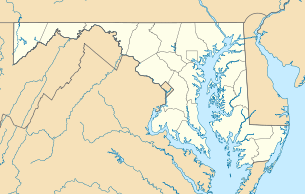Port Tobacco
| Port Tobacco, Maryland | |
|---|---|
| Unincorporated community | |
|
Maryland Roadside Historical Marker CH-372 | |
 Port Tobacco Location within the State of Maryland | |
| Coordinates: 38°30′41″N 77°1′12″W / 38.51139°N 77.02000°WCoordinates: 38°30′41″N 77°1′12″W / 38.51139°N 77.02000°W | |
| Country | United States |
| State | Maryland |
| County | Charles |
| Time zone | Eastern (EST) (UTC-5) |
| • Summer (DST) | EDT (UTC-4) |
Port Tobacco is an unincorporated community in Charles County, Maryland. Once a bustling port providing indirect access to the Potomac River, Port Tobacco was a commercial hub for colonial Maryland and served as the county seat of Charles County from 1658 to 1895.[1] Unfortunately, erosion from excessive agricultural use and poor soil conservation caused significant siltation at the head of the Port Tobacco River, which eventually became unnavigable to larger merchant vessels. As such, commercial activity at the port dwindled by the time of the Civil War.[2]
In 1888, a small portion of the town's square incorporated as Port Tobacco Village[3][4] and may have signaled an attempt by the town's residents to address the port's decline.[2] That decline, however, was only exacerbated by the completion of a nearby rail line to Pope's Creek in 1873 operated by the Baltimore and Potomac Railroad.[5] The new line bypassed Port Tobacco and ran further south to another port directly on the Potomac River. New communities eventually sprang up along the railway and prospered, including the town of LaPlata, which succeeded Port Tobacco as the county seat in 1895.
Historic landmarks within Port Tobacco include Chapel Point, home of St. Thomas Manor and St. Ignatius Church, the oldest continuously active Jesuit complex in the world, and the oldest Catholic parish in the Thirteen Colonies; Mulberry Grove, the birthplace of John Hanson; and Rose Hill manor house.
In addition to Rose Hill and St. Thomas Manor, Ellerslie, Thomas Stone National Historic Site, Linden, Mt. Carmel Monastery, Port Tobacco Historic District, Retreat, and Stagg Hall are listed on the National Register of Historic Places.[6]
References
- ↑ "Port Tobacco boasts history, little else". The Baltimore Sun. Retrieved July 19, 2014.
- ↑ 2.0 2.1 April M. Beisaw (September 2007). "Once Was Not Enough: Founding and Finding Port Tobacco, Charles County". Maryland Archeology (Academia). 43(2): 1–6. Retrieved July 19, 2014.
- ↑ "Municipalities & Population Centers - Port Tobacco". Charles County Government. Retrieved January 11, 2014. "Today just 13 residents live within the incorporated borders of Port Tobacco Village, but the many surrounding neighborhoods add to this community known for its rich heritage and historical significance."
- ↑ "Port Tobacco". Maryland Manual Online. Maryland State Archives. Retrieved January 11, 2014.
- ↑ "LaPlata Train Station". Charles County Government. Retrieved July 17, 2014.
- ↑ "National Register Information System". National Register of Historic Places. National Park Service. 2010-07-09.
| |||||||||||||||||||||
